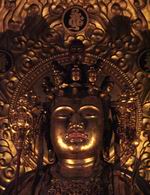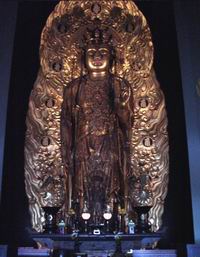

The Kannon-do(Kannon Hall)
The central image is the Juichimen Kannon, the bodhisattva Avalokitesvara
represented with eleven faces. Its 9.18 meter height makes it the largest wooden
sculpture in Japan. Known as the "Hase Kannon", the sculpture's eleven faces,
each with a different expression, represent eleven aspects of the bodhisattva;
three each face forward, left, and right, one is at the rear of the head, and
one above crowns them. These symbolize Kannon's hearing prayers and saving all
sentient beings.

Unlike most images of Kannon, the Hase Kannon holds a monk's staff with metal rings(khakkhara) in the right hand and vase with a lotus flower in the left hand. This distinctive pose, called the Hase-dera style, combines attributes often associated with the bodhisattva Jizo with those of Kannon. Many, regarding the image as combining the power of Kannon and Jizo, have a fervent faith in it.
Hase-dera, long a major center of Kannon worship, is the fourth temple on the Bando Pilgrimage to 33 Sites Sacred to Kannon, which was established in the thirteenth century. HOME